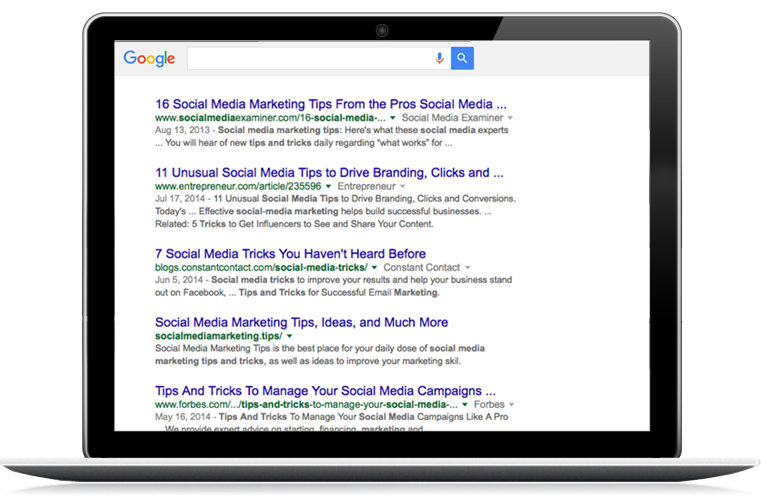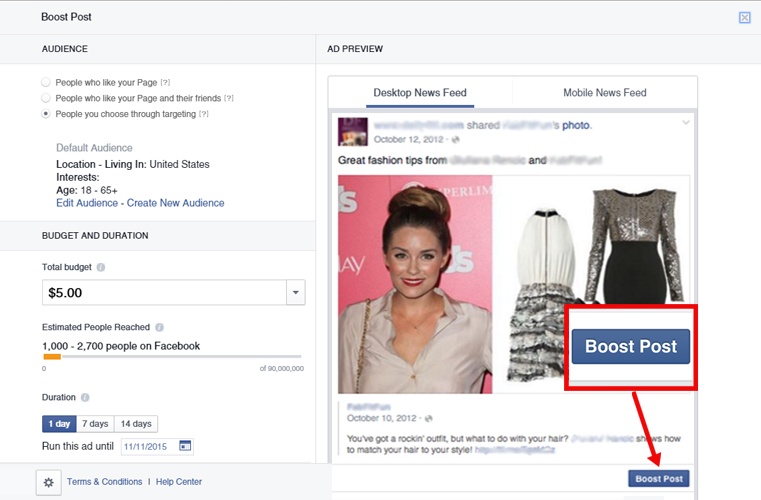 Social media is so simple anyone can do it.
Social media is so simple anyone can do it.
Wait, scratch that.
Social media is so simple anyone can do it wrong. Let's look at how you can stay in front of a social media blunder and create the kind of social media presence that can actually help your audience while promoting your brand.
19 Ways to Boost Your Social Media ROI
Google tips on effective social media marketing and you'll find a long, long list of listicles like "X Time-Tested Twitter Tips" and "Y Facebook Hacks To Boost Your Inbound Marketing!" But before you start following the advice, remember one simple rule:
1. Check the Expiration Date!
 Some of the top ranking social media marketing guides were written all the way back in 2012, or even 2011. That's at least five decades in Internet Years.
Some of the top ranking social media marketing guides were written all the way back in 2012, or even 2011. That's at least five decades in Internet Years.
What's worse -- there's something no other inbound marketing agency is going to warn you about. Unless you know how to read the metrics, there's no way to know whether you're actually seeing a Return on Investment for all that time you sink into social media marketing.
Today, we can show you how to not only optimize your social media marketing for 2016, but how to stop wasting your time and boost the ROI you get from social media. If you follow our advice, you can actually spend less time on social media but increase your ROI. We'll walk you through it...
2. Press the Reset Button
 Just how useless is the average social media marketing guide? About as useful as Facebook is to the average Do It Yourself marketer - so not very useful at all...
Just how useless is the average social media marketing guide? About as useful as Facebook is to the average Do It Yourself marketer - so not very useful at all...
Unless you already know what you're doing, many social media guides are likely going to send you chasing dead ends. In 2014, digital marketers panicked when their content -- all those gifs and videos and blog posts -- disappeared from their fans' feeds. Suddenly, they now had to pay to "Boost" or "Promote" those posts. That means any social media marketing guide written before Spring 2014 is completely and totally useless when it comes to marketing on Facebook.
And that's just one of the myriad changes that the social media giant has made since then. Now, we hear this all the time: “I'm not seeing results from my social media marketing efforts, what gives?"
3. Narrow It Down
![]() The average inbound marketing agency also moonlights as Silicon Valley's unofficial cheerleading squad. While it can be worthwhile to set up accounts on various social media platforms (Linkedin, Facebook, Twitter, Pinterest, YouTube, Yelp, etc), you shouldn't try and reach your customers on all of them.
The average inbound marketing agency also moonlights as Silicon Valley's unofficial cheerleading squad. While it can be worthwhile to set up accounts on various social media platforms (Linkedin, Facebook, Twitter, Pinterest, YouTube, Yelp, etc), you shouldn't try and reach your customers on all of them.
By all means, make profiles on every site you can, but to be an effective marketer, you need a laser-like focus. That means going where your customers already are. For younger crowds, that likely means Twitter. For 30-something professionals, LinkedIn.
Hold Up.
How do you know which social media sites your customers use? Wait for it... Try asking them! Remember that? Face-to-face interactions? Talk to your customers or ask them to fill out a survey. Then come up with a short list of the most important social media networks to target.
Let's start with Facebook. In 2015, the digital marketing world has been buzzing about a case study promising you can "dominate Facebook" with just a $5 ad buy. How does it work?
4. The $5 Facebook Marketing Strategy
First off: unlike social media marketing guru, Rebecca Coleman, we aren't going to promise that this strategy will boost your ROI on Facebook. But we are confident it can help turn around a stalled strategy.
Remember: Without great content or promotions to share, it doesn't matter how much money you spend boosting your post. So, let's say you have the content (and if not, keep reading). How do you actually boost your reach with just $5?
Unsurprisingly, Facebook makes it pretty easy for you to give them money.

This is the important bit -- you have to decide who to target with your purchase. Coleman suggests:
"FB gives you a choice of three audiences to target: people who already like your page (who are important to me, but they probably already know about the show, so I don’t need to heavily target them), People who like the page and their friends (better–we’re reaching out to “warm leads”), or a target audience that I define...My reach to just people on my page was estimated at 370-870, to people who like the page and their friends, 2,100-5,600, and to a target audience I define, 1,800-4,700, so always choose the second or third options."So are you ready to boost? Before you go live with your very first Facebook ad - wait. There's one more thing you have to do first.
5. Analyze Your Analytics
Go over your numbers and determine which past posts had the highest reach. Facebook's "Insights" tab has tons of useful information, but you want to focus on the three main info boxes, Likes, Reach and Engagement.
 Go over your past posts and determine which type of content most successfully reached your existing customers and followers. Chances are, posts like this will work well with new customers, too. Then...
Go over your past posts and determine which type of content most successfully reached your existing customers and followers. Chances are, posts like this will work well with new customers, too. Then...
6. Give the People What They Want
Business2Community ran a post with some crucial caveats to the famous $5 marketing plan. Most importantly:"Be judicious. It’s dumb to try to boost every single Facebook post, or to sink money into the most minor or trivial status update. Part of maximizing your ad spend is not spending on too many superfluous ads...Original media is key. You’re not going to get traction on a post that uses a stock photo or some other generic media -- no matter how much money you invest in it. Make sure to always use original, compelling photos and videos that unmistakably reflect your brand and your voice."
What if you don't have compelling content like original photos or infographics to share?
Well, you've just pinpointed the reason your social media marketing plan is stuck in the mud. Stock photos are useful, and every marketer uses them to some degree. There’s just a limit to the number of inbound clicks you’ll get with a generic stock photo like, “Multiracial Group of People Jumping at Beach.” Or just look at this inspiring stock photo depicting a multi-ethnic group of generically attractive workplace acquaintances in the middle of a super casual brainstorming sesh hashtag crushing it hashtag cool idea, Steve! It’s a fine photo (and yes, we did pay for it), but will it get people to click?

7. Visualize It
We could throw a bunch of stats at you explaining exactly why our inbound marketing agency plans to increase our use of visual assets this year, but all you have to do is spend a few minutes scrolling through Facebook and Twitter to see that it's true.
This is usually when people panic. What if you don't have the resources for video production or highly detailed infographics? That doesn't mean you're off the hook. If you want to boost your reach on any social media app, you'll need to find a way to visualize your content. This doesn't have to be high-tech. New media upstarts like Vox.com have a knack for taking simple quotes and turning them into bite-sized infographics, like so:
Tipping perpetuates racism, classism, and poverty — let's get rid of it! http://t.co/CEzypm5SKz pic.twitter.com/4ybTfwDcfm
— Vox (@voxdotcom) October 15, 2015
It's the modern day soundbyte, and it's the perfect way to get started with visual assets.
8. Provide "Value-Added Content" to Your Followers
Too many small business owners agonize over their disappointing traffic.
They rail against Facebook and self-obsessed Millennials. But if your content marketing isn't working, make better content. This is a trick we call "value-added content."
The prevailing wisdom among inbound marketing agencies today -- whether they're content pros, search marketing gurus, or social media hacks -- is this: if you make great content, people will share it. Which is probably true, so long as your name is Jimmy Fallon and you have 8.5 million YouTube subscribers. For the rest of us mortals, you need a backup plan.
If your posts still aren't getting any traction, then it's time to give your users something of real value. That means your social media posts have to offer something customers can actually use. You can even do this just by highlighting your existing promotions. Many small businesses already have a discount for seniors, students, or veterans. Before Veteran’s Day, spend $5 promoting a post advertising your incredible discount for veterans. And don't just throw up a stock photo, either.
9. Encourage Engagement
It's not enough to make your pitch. Convince your fans to actually engage with your post. In the example above we suggested boosting a post about a veterans’ discount ahead of Veteran’s Day. So what now?
Encourage people to tag or share the post with veterans they know. If it's a senior discount, tell people to tag their grandparents or neighbors to automatically qualify them for the promotion.
Remember: you can’t force your employees to Like, Share, and Retweet your social media posts, but you can incentivize them with coffee and donuts.
10. The Vanity Post
Another great way to encourage engagement? The Vanity Post.
The veterinarian where I take my dogs has monthly content called "Pet of the Month!" Each week, the vet posts an adorable photo of an animal and then tags its owner. At the end of the month, whichever post has the most likes gets a discount on their next visit. People are so happy to see their furry best friend on the Internet that they ask friends and family to like the post.
Of course, veterinarians don’t know how good they have it when it comes to social media and inbound marketing. Try being a trench-less sewer company...
11. Make Connections
 So far we've been concentrating on Facebook, but many of these strategies apply to other social networks as well. And that goes double for this: Every post cannot be an advertisement.
So far we've been concentrating on Facebook, but many of these strategies apply to other social networks as well. And that goes double for this: Every post cannot be an advertisement.
For every promotion, call to action, or ad, you need four information posts. No one is going to click on your timeline or Twitter feed and spend their time reading a list of advertisements. And if you want people to follow you, you have to be willing to follow back.
At our inbound marketing agency, we've found one of the best ways to earn links is to give links. And while it's not actually better to give a link than to receive one -- not even close -- you have to start building connections. If you see a post you like, "Like" it. If you see a Tweet you think your followers might like, "Retweet" it. And so on.
12. Check Your Reach, Again
Even if this boosted post doesn't work, you've only spent $5. If your business can't survive that loss, then you've got bigger problems than your social media campaign.
Now, we're going to suggest something completely insane, something so crazy you might just stop reading right now... You've already spent $5. Now, spend $15 more... We know, that's a lot of money. You're practically funding Mark Zuckerberg's new San Francisco mansion... but you need to do some A/B testing.
Once you've identified the kinds of posts your fans and followers like, start building up similar content. Over the course of two or three months, boost three or four more posts. Set a firm schedule to check in on your social media analytics. Trust us, you don't want to get in the habit of obsessively, compulsively, addictively checking every hour (there’s a popular real-time analytics program called Chartbeat, and there’s a reason some online marketing agencies call it Crackbeat).
Pick a day of the week, pick a time, and go over the numbers. Is it working yet? If it's working, then wait a few weeks and try, try again. If it's not working, then...
13. It May Be Time To Move On
So you've spent months trying to optimize your Facebook marketing strategy and it's just not working. Now what?
That's right, it's time for Twitter. On a good day, Twitter can be an incredible tool for making new connections. On a bad day, it can feel like wading into a swimming pool full of sewage. Twitter originally became famous as a "micro-blogging" site, with its tiny 140-character posts. It helped popularize the hashtag -- which we used to call the pound sign back in the day -- and terms like "trending."
It's important to spend some time on Twitter, or whichever social media site you choose to target, to get the feel of things. Pay attention to the language people use, the hashtags they use, and so on. But just remember, don't do this:
14. You Are Not Bae

Wait a second... a brand tweeted this? But it says "on fleek" - that's not something a brand would normally tweet! pic.twitter.com/6nf5u5tEMA
— Brands Saying Bae (@BrandsSayingBae) December 28, 2014
Or this:
The evolution of a brand. Inspiring. pic.twitter.com/3yocN23LY6
— Brands Saying Bae (@BrandsSayingBae) December 28, 2014
We get it, we all want to be bae. We all want to be on fleek sometimes. And some brands have successfully incorporated teen slang into their social media, either ironically or naturally.
But on social media, as in the middle school cafeteria, young consumers are incredibly savvy.You might want to settle for a nice emoji instead. People can tell when brands are trying too hard, and there’s no better way to make people click on that block button than the smell of desperation.
Twitter is full of Trending Topics, and you'll want to engage with them carefully when promoting your business. If your social media account is primarily about inbound marketing, you shouldn't be using it to support many hashtags that start with "#PrayFor..."
Just look at this famous example from the annals of social media history, posted (and quickly deleted) following the Boston Marathon bombing. Like all hastily deleted tweets, it’s gone but not forgotten:

SMDH. See, now that’s how you use the cool teen slang. If there’s a cause your business has supported in the past, by all means promote it, just don’t promote yourself at the same time. Now it’s time to start posting your content and links, like you did on Facebook. The better your content, the more engagement you'll see.
15. Direct Messages
Remember when we told you to start reaching out to make connections? To start following and liking other posts?
Twitter truly can be an incredible resource for making genuine connections, so long as you don't try too hard. Reaching out directly to customers through direct messaging is almost always a bad idea, unless the customer initiates the conversation, but Twitter can be a great way to build connections with others in your industry.
If there's a popular social media account about your industry, consider sending them a direct message. Pretend you're networking in real life, and just start with, "Hello." If customers contact your business through Twitter, respond directly and promptly.
16. Checking Analytics, Again
Whether you select Twitter, Instagram, or Pinterest as a site to target, virtually every one of these apps has a dashboard or "Insights" section where you can check your analytics.
On Twitter, you can find the analytics dashboard here, and there's a wealth of information for checking your reach. Just like you did with Facebook, set a fixed time to go over your posts and check the numbers.
Remember: Social media marketing is like SEO. It’s a long-term strategy. If you still aren’t seeing results month after month, then maybe your time is better spent on another social networking app.
17. Play To Your Strengths
If you’re a trench-less plumber, chances are you don’t have tons of visual content that would play well on Pinterest or Instagram. However, the people you need to meet to gain those lucrative municipal contracts probably spend their cyber-loafing time cruising LinkedIn.
A home renovator could post photos of his or her creations on Instagram. Likewise a wedding hall will likely have a major leg up on Pinterest. Remember when we talked about the vanity post? Think strategically about where else your company can play to your strengths online and interact with existing customers.
18. Remember: It’s Called Social Media Marketing, Not Advertising
Anyone who’s worked at an inbound marketing agency will be familiar with this conversation: You’re advising a client on social media marketing strategies, and they aren’t happy. Where’s the post about “10 Reasons You Should Definitely Buy Hose Clamps from Hose Clamps Direct Because Hose Clamps are Awesome”?
You can’t simply post a list of advertisements. You have to give the people what they want. On Pinterest, that means “pinning” other users’ content to your board. It means building up followers over time with all your great content.
Ask yourself: “Would this post actually be of interest to the average user, or is it just an advertisement they’ll ignore?” Eventually, people will start pinning your original, branded content to their walls. And that’s your way in…
19. Boost ROI or Bust
 Here's what no other social media guide will tell you: If you try everything on this page, and you still aren't seeing any results from social media marketing, then it's okay to quit.
Here's what no other social media guide will tell you: If you try everything on this page, and you still aren't seeing any results from social media marketing, then it's okay to quit.
Yes, you read that right. We're giving you permission to quit social media. BUT only if you've tried everything on this page (and then tried it again).
Here's the deal: your local veterinary office really does have the social media jackpot barking and meowing in their waiting room every morning. A major corporation can spend a million dollars throwing junk at the social media wall to see what sticks.
Here’s a classic example of when social media doesn’t work. Imagine you’re the administrator of a mental health and addiction treatment center. By law, you absolutely cannot reveal who your patients are, and clients aren't exactly lining up to "Like" your Facebook page. Although you shouldn’t delete your Facebook or Twitter profiles altogether, perhaps your time would be better spent on a PPC campaign. And that's what it comes down to.
Once you've tested out these different approaches and carefully check the numbers. If your reach isn't increasing, if no new inbound leads are coming in, then the ROI you're getting might actually be negative.
To learn more about the impact that inbound marketing can have on your business, contact us today or download our latest eBook!
Topics: Social Media










